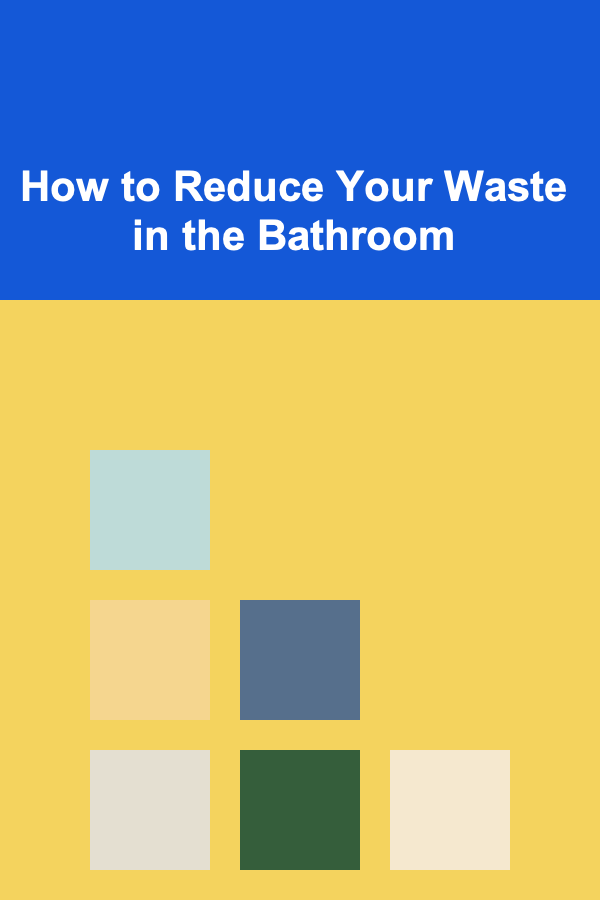
How to Reduce Your Waste in the Bathroom
ebook include PDF & Audio bundle (Micro Guide)
$12.99$9.99
Limited Time Offer! Order within the next:

The bathroom is one of the most waste-intensive areas in our homes. From single-use toiletries to disposable cleaning products, it's easy to overlook the significant amount of waste that accumulates over time. However, as global awareness of environmental issues grows, more people are seeking ways to minimize their ecological footprint. Reducing waste in the bathroom not only helps decrease the strain on landfills but also promotes a more sustainable and eco-friendly lifestyle.
In this comprehensive guide, we will explore actionable strategies and eco-friendly alternatives to reduce bathroom waste. From personal care products to cleaning supplies, we will cover how you can make small yet impactful changes that lead to a cleaner planet.
Reducing Personal Care Waste
One of the primary contributors to bathroom waste is personal care products. Many items like plastic bottles, cotton swabs, and razors are used once and then discarded. These products can take years to decompose, which significantly impacts the environment. Below are several ways to minimize personal care waste without compromising hygiene or quality.
1.1. Choose Solid Alternatives
A great starting point is to switch from liquid to solid personal care products. Solid products generally have less packaging, reducing plastic waste significantly. Here are some solid alternatives you can consider:
- Bar Soap: Traditional bar soap is often less wasteful than liquid soap because it doesn't require plastic packaging. Look for soaps that come in paper or compostable packaging.
- Shampoo Bars: Instead of using shampoo that comes in plastic bottles, opt for shampoo bars. They are usually long-lasting and come in eco-friendly packaging, reducing both plastic waste and water usage.
- Solid Conditioner: Similar to shampoo bars, solid conditioners are a sustainable alternative. These bars typically last longer than liquid conditioners, offering both an economic and environmental benefit.
1.2. Switch to Reusable Items
Another simple way to reduce waste is to replace disposable personal care products with reusable ones. This switch often leads to significant long-term savings and a reduction in the waste you generate.
- Reusable Cotton Pads: Instead of single-use cotton pads for makeup removal or skincare, invest in reusable cotton pads. These are washable and can be used multiple times before needing replacement.
- Menstrual Cups: Traditional tampons and pads generate a great deal of waste. A menstrual cup, made from medical-grade silicone, is a durable and reusable alternative that can last for years, reducing monthly waste significantly.
- Safety Razors: Traditional razors often come with plastic handles and disposable heads that can't be recycled. A safety razor is a durable, metal alternative that uses replaceable razor blades, drastically reducing plastic waste.
1.3. Opt for Eco-Friendly Products
When purchasing personal care products, it's important to choose those that are eco-friendly, cruelty-free, and made with natural ingredients. These products are not only better for your health but also for the environment.
- Plastic-Free Packaging: Look for personal care products that come in plastic-free packaging, such as glass containers, aluminum tins, or cardboard boxes. Many brands are now offering packaging made from recyclable or biodegradable materials.
- Natural and Biodegradable Ingredients: Choose products with natural, plant-based ingredients that are less likely to harm the environment when washed down the drain. Avoid products with microplastics or harmful chemicals that can end up in waterways.
Minimizing Waste from Toilet Paper
Toilet paper is one of the most commonly used items in the bathroom, and unfortunately, it often comes wrapped in plastic, contributing to a significant amount of waste. Fortunately, there are several ways to reduce this particular waste stream.
2.1. Switch to Bamboo Toilet Paper
Bamboo is a highly sustainable material because it grows quickly and requires little water or pesticides. Bamboo toilet paper is biodegradable and compostable, making it an environmentally friendly alternative to traditional toilet paper. Many brands offer bamboo toilet paper that comes in paper-based or plastic-free packaging.
2.2. Consider a Bidet
Using a bidet can greatly reduce your reliance on toilet paper. By washing instead of wiping, you not only cut down on the amount of toilet paper used but also reduce the environmental impact of paper production and waste. Bidets are water-efficient and are becoming more widely available as affordable, easy-to-install fixtures.
2.3. Opt for Toilet Paper Without Plastic Packaging
If you're unable to switch to a bidet, the next best option is to buy toilet paper that's packaged without plastic. Many brands now offer toilet paper wrapped in recyclable paper, making it a more sustainable choice.
Sustainable Bathroom Cleaning
Cleaning products are essential for maintaining hygiene, but they often come in plastic bottles, contain toxic chemicals, and contribute to waste when disposed of. Luckily, there are various ways to reduce waste while still keeping your bathroom sparkling clean.
3.1. Use Multi-Purpose Cleaners
Instead of purchasing multiple cleaning products for different surfaces, switch to multi-purpose cleaners that can handle a variety of tasks. This reduces the number of cleaning products you need to buy, which in turn reduces packaging waste. Many natural and eco-friendly multi-purpose cleaners come in glass bottles or refillable containers.
3.2. Make Your Own Cleaning Products
A cost-effective and eco-friendly option is to make your own bathroom cleaning products using natural ingredients. For example, a mixture of vinegar, baking soda, and lemon juice can be used to clean surfaces, remove stains, and eliminate odors. By using ingredients you likely already have at home, you avoid purchasing disposable cleaning supplies and reduce plastic waste.
3.3. Switch to Reusable Cleaning Cloths
Instead of using disposable paper towels to clean your bathroom, opt for reusable microfiber cloths. These can be washed and reused multiple times, reducing both paper waste and the need for additional cleaning products. Microfiber cloths are highly effective at trapping dust, dirt, and bacteria, making them perfect for bathroom cleaning.
3.4. Buy Concentrated Cleaning Products
Many cleaning products come in concentrated forms, which require less packaging and reduce shipping waste. These concentrated products can be diluted with water to create a ready-to-use cleaner. This option cuts down on plastic bottle waste and makes cleaning products last longer.
Waste Reduction in Bathroom Towels and Linens
Towels and bathroom linens are used frequently but often discarded or replaced far too often. They are generally made from cotton, a resource that requires substantial water and energy to grow. However, there are ways to make your towel usage more sustainable.
4.1. Choose Organic Cotton Towels
If you need to purchase new towels, consider opting for organic cotton towels. Organic cotton is grown without the use of harmful pesticides and synthetic fertilizers, making it a better option for the environment. Organic cotton towels are often softer and more durable, meaning they last longer, reducing the need for replacements.
4.2. Wash Towels Wisely
Instead of washing towels after every use, consider washing them less frequently. By using towels multiple times between washes, you can conserve water, energy, and detergent. Additionally, when you do wash towels, always wash full loads to maximize efficiency.
4.3. Avoid Using Single-Use Towels
Many disposable towels or wipes are marketed for bathroom use, including facial tissues and makeup wipes. These are often made from synthetic materials that do not biodegrade and contribute to significant landfill waste. Instead, switch to reusable face cloths, hand towels, and washcloths, all of which can be washed and used repeatedly.
Reducing Plastic Waste in the Bathroom
Plastic is one of the most significant contributors to waste in the bathroom. It's essential to reduce plastic use wherever possible and replace it with more sustainable materials.
5.1. Choose Plastic-Free Personal Care Products
Many personal care products, from toothbrushes to hair care products, come in plastic packaging. Switching to plastic-free alternatives, such as bamboo toothbrushes or refillable deodorants, can drastically reduce bathroom waste.
5.2. Refill and Reuse Containers
Instead of buying new products in plastic containers, opt for refillable containers. Many eco-friendly brands offer refill options, and some stores even sell bulk products that you can pour into your own containers.
5.3. Avoid Single-Use Plastic Items
The bathroom is home to a variety of single-use plastic items, including plastic razors, cotton swabs, and shower caps. By opting for reusable versions of these items, you can eliminate the need for disposable plastics in your bathroom routine.
Conclusion
Reducing waste in the bathroom is a simple yet effective way to live more sustainably. By making small, intentional changes, such as switching to reusable products, choosing eco-friendly packaging, and reducing plastic use, you can significantly decrease the environmental impact of your bathroom routine. While it may take time to fully transition to a zero-waste bathroom, every step you take contributes to a more sustainable future for the planet. Whether you choose to switch to bamboo toilet paper, opt for a bidet, or embrace natural cleaning products, the choices you make today will help protect the environment for generations to come.

Becoming a Cloud Engineer: Key Strategies for Optimizing Cloud Architecture
Read More
How to Keep Your Home Clean with Pets Around
Read More
How to Secure Your Data on Old Devices Before Disposal
Read More
Finding Language Learning Resources for Free: A Comprehensive Guide
Read More
10 Tips for Planning a Scuba Diving Trip During Peak Season
Read More
10 Tips for Lighting a Scene on a Tiny Budget
Read MoreOther Products

Becoming a Cloud Engineer: Key Strategies for Optimizing Cloud Architecture
Read More
How to Keep Your Home Clean with Pets Around
Read More
How to Secure Your Data on Old Devices Before Disposal
Read More
Finding Language Learning Resources for Free: A Comprehensive Guide
Read More
10 Tips for Planning a Scuba Diving Trip During Peak Season
Read More